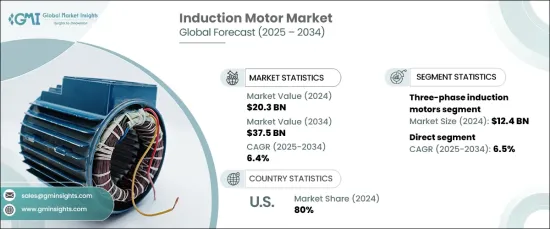
세계의 유도 전동기 시장은 2024년까지 203억 달러에 이른 것으로 평가되었고, 2025년부터 2034년까지 CAGR은 6.4%로 확대될 것으로 예측되고 있습니다. 내구성, 효율성, 범용성으로 유명한 유도 전동기는 자동화된 생산 라인의 전원으로 중요한 역할을 합니다. 유도 전동기는 컨베이어, 로봇 시스템, 자동 기계 등 제조 환경에서 사용되는 기계에 정확한 제어를 제공하는 데 필수적입니다.

생산성 향상과 인건비 절감을 목적으로 하는 산업용 오토메이션의 채용이 증가하고 있는 것이 시장 성장의 주요 요인입니다. 유도 전동기는 특히 제조, 물류, 창고, 의료 등의 산업에서 로봇 및 무인 운송 차량(AGV)과 같은 부문에서 널리 사용됩니다. 이러한 모터는 안정된 속도와 신뢰성 높은 토크를 제공하는 능력을 높이 평가하며, 무정지 운전이 필요한 고성능 용도에 이상적입니다. 게다가 에너지 효율을 중시하는 경향이 강해지면서 지속가능한 산업 프랙티스를 지원하는 에너지 절약 모터 수요도 급증하고 있습니다.
| 시장 범위 | |
|---|---|
| 시작 연도 | 2024년 |
| 예측 연도 | 2025-2034년 |
| 시작 금액 | 203억 달러 |
| 예측 금액 | 375억 달러 |
| CAGR | 6.4% |
시장은 제품 유형별로 단상과 삼상 유도 전동기로 나뉩니다. 삼상 부문은 시장을 선도하며 2024년에는 124억 달러의 수익을 창출했습니다. 이 부문은 펌프, 압축기, 컨베이어 시스템 등 고효율 및 고부하 처리 능력을 필요로 하는 산업 분야에서 널리 사용되는 것이 원동력이 되며, 2034년까지 연평균 복합 성장률(CAGR) 6.5%로 성장할 것으로 예상됩니다. 자동화로의 변화가 진행되고 산업화가 급속히 진행됨에 따라 제조 공정에서 이러한 견고한 전동기 수요가 더욱 커지고 있습니다.
유통 채널의 경우 시장은 직접 판매와 간접 판매로 나뉩니다. 직접 판매 부문이 우세하고 2024년 시장 점유율 전체의 65.8%를 차지했으며, 예측 기간 중 CAGR은 6.5%로 예상됩니다. 산업이 맞춤형 고효율 솔루션을 추구함에 따라 보다 빠르고 투명한 거래를 제공할 수 있는 직접 유통 채널 선호도가 계속 증가하고 있습니다. 온라인 판매 플랫폼의 통합으로 고객 참여도가 더욱 향상되고 구매 프로세스가 더욱 용이하고 간소화됩니다.
미국의 유도 전동기 시장은 2024년에 80%의 점유율을 차지했으며, 2025년부터 2034년까지 CAGR 6.4%를 나타낼 것으로 예측됩니다. 이 성장의 원동력이 되고 있는 것은 다양한 부문에서 산업 오토메이션, 에너지 효율, 근대화가 중시되고 있다는 것입니다. 자동차, 화학가공, 식품제조 등의 산업에서는 첨단 시스템을 통합하여 생산성을 높이는 동시에 운영비용을 절감하고 있습니다.
The Global Induction Motor Market is on track to reach USD 20.3 billion by 2024 and is projected to expand at a CAGR of 6.4% from 2025 to 2034. Renowned for their durability, efficiency, and versatility, induction motors play a crucial role in powering automated production lines. They are integral in providing precise control for machinery used in manufacturing environments, such as conveyors, robotic systems, and automated machinery.

The increasing adoption of industrial automation to enhance productivity and reduce labor costs is a primary driver of market growth. Induction motors are widely utilized in sectors like robotics and automated guided vehicles (AGVs), particularly in industries such as manufacturing, logistics, warehousing, and healthcare. These motors are highly valued for their ability to deliver consistent speed and reliable torque, making them ideal for high-performance applications that require uninterrupted operation. Additionally, the growing emphasis on energy efficiency has led to a surge in demand for energy-saving motors, which supports sustainable industrial practices.
| Market Scope | |
|---|---|
| Start Year | 2024 |
| Forecast Year | 2025-2034 |
| Start Value | $20.3 Billion |
| Forecast Value | $37.5 Billion |
| CAGR | 6.4% |
The market is divided by product type into single-phase and three-phase induction motors. The three-phase segment leads the market, generating USD 12.4 billion in revenue in 2024. This segment is expected to grow at a CAGR of 6.5% through 2034, driven by its widespread use in industrial applications requiring high efficiency and the ability to handle heavy loads, such as pumps, compressors, and conveyor systems. The increasing shift toward automation and rapid industrialization further fuels the demand for these robust motors in manufacturing processes.
In terms of distribution channels, the market is split between direct and indirect sales. The direct sales segment dominates, accounting for 65.8% of the total market share in 2024, and is expected to experience a CAGR of 6.5% during the forecast period. As industries increasingly demand customized, high-efficiency solutions, the preference for direct sales channels continues to rise, thanks to their ability to provide faster, more transparent transactions. The integration of online sales platforms is further improving customer engagement, making the purchasing process more accessible and streamlined.
The U.S. induction motor market held an 80% share in 2024 and is projected to grow at a CAGR of 6.4% from 2025 to 2034. This growth is fueled by the increasing emphasis on industrial automation, energy efficiency, and modernization within various sectors. Industries such as automotive, chemical processing, and food production are integrating advanced systems to boost productivity while reducing operational costs.